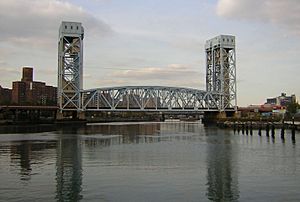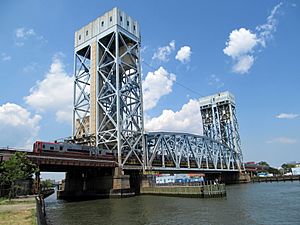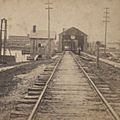Harlem River Lift Bridge facts for kids
Quick facts for kids Harlem River Lift Bridge |
|
|---|---|

From downriver
|
|
| Carries | 4 tracks of the Metro-North Railroad |
| Crosses | Harlem River |
| Locale | Manhattan and the Bronx in New York City |
| Maintained by | Metropolitan Transportation Authority |
| Characteristics | |
| Design | Vertical lift bridge |
| Longest span | 340 ft (100 m) |
| Clearance below | 25 ft (7.6 m). (closed) and 135 ft (41 m). (open) |
| History | |
| Opened | 1956 (replacing 1897 bridge) |
The Harlem River Lift Bridge is a special kind of bridge in New York City. It's also called the Park Avenue Bridge. This bridge carries four different train tracks for the Metro-North Railroad. It crosses the Harlem River, connecting the areas of Manhattan and the Bronx. Lots of people use these train lines every day, about 265,000!
Contents
History of the Harlem River Bridge
The First Bridge (1841)
The very first bridge at this spot was built in 1841 by the New York and Harlem Railroad. It was made of four long sections, each about 90 feet (27 meters) long. Three sections were fixed iron parts. The last section was a wooden swing span. A swing span is a part of a bridge that can turn open to let boats pass.
When this first bridge was closed, it was only about 7 feet (2 meters) above the water. This meant only small boats could go under it. In 1867, the wooden swing part was replaced with an iron one. This new part allowed boats to pass with 50 feet (15 meters) of space. By the 1880s, more than 200 trains crossed this bridge every single day!
The Second Bridge (1897)
Soon, the 1867 bridge became too old for the many trains and the busy river. The United States Department of War wanted to make the Harlem River easier for ships to use. They wanted to connect the Hudson River and the East River better.
The New York Central Railroad, which owned the bridge, didn't like this plan. Their bridge was very low, only 8 feet (2.4 meters) above the water. This low height caused delays for ships. To fix this, the railroad could either raise the bridge or build a tunnel. They chose to raise the bridge.
A new four-track swing bridge was designed by Alfred P. Boller. This new bridge was much higher, about 24 feet (7.3 meters) above the water. This was a big project, costing about $500,000. It also meant the train tracks leading to the bridge had to be raised. A new steel structure was built for the tracks.
During construction, trains still ran over a temporary wooden bridge. This complex work took several years. On February 15, 1897, trains finally started using the new, higher swing bridge. The Department of War made a rule that the bridge could not open during busy times for trains.
The Current Bridge (1956)
The bridge we see today was built between 1954 and 1956. The New York Central Railroad replaced the 1897 swing bridge with a new type: a vertical lift bridge. A vertical lift bridge is a bridge where the middle part lifts straight up, like an elevator, to let tall ships pass.
This modern bridge opened in 1956. It has four tracks and is about 340 feet (104 meters) long. When the bridge is closed, there is 25 feet (7.6 meters) of space underneath for boats. When it's open, it provides a huge 135 feet (41 meters) of space!
Over the years, the bridge was owned by different companies. Today, the Metro-North Railroad operates it. They call it the Harlem River Lift Bridge.
Images for kids



